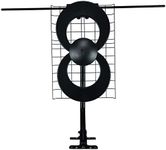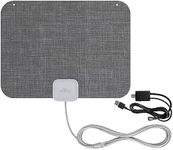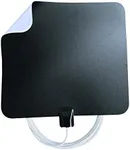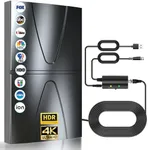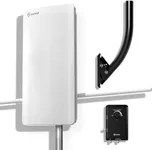Buying Guide for the Best Indoor TV Antennas
Choosing the right indoor TV antenna can significantly enhance your television viewing experience by providing access to a variety of channels without the need for a cable subscription. To find the best fit for your needs, it's important to understand the key specifications and how they impact performance. Here are the main factors to consider when selecting an indoor TV antenna.RangeThe range of an indoor TV antenna indicates how far it can receive signals from broadcast towers. This is crucial because it determines the number of channels you can access. Antennas with a range of 20-30 miles are suitable for urban areas where broadcast towers are nearby. For suburban areas, a range of 30-50 miles is often sufficient. If you live in a rural area, you may need an antenna with a range of 50 miles or more. To choose the right range, consider your distance from the nearest broadcast towers and the type of area you live in.
Frequency BandsIndoor TV antennas can receive signals on different frequency bands, primarily VHF (Very High Frequency) and UHF (Ultra High Frequency). VHF channels are typically channels 2-13, while UHF channels are 14-51. Some antennas are designed to receive both VHF and UHF signals, which is ideal for accessing a wider range of channels. If you know that your favorite channels are broadcast on a specific frequency band, you can choose an antenna that specializes in that band. However, for the best overall performance, a dual-band antenna is recommended.
AmplificationAmplified antennas come with a built-in signal booster to enhance weak signals, which can be particularly useful if you are far from broadcast towers or if there are obstacles like buildings or trees that may interfere with the signal. Non-amplified antennas rely solely on their design to capture signals. If you live in an area with strong signal reception, a non-amplified antenna may suffice. However, if you experience weak or inconsistent signals, an amplified antenna can help improve reception quality.
Design and SizeIndoor TV antennas come in various designs and sizes, from flat, paper-thin models to more traditional rabbit ear styles. The design can affect both the performance and the ease of installation. Flat antennas are often more discreet and can be mounted on walls or windows, making them a good choice for those who want a low-profile option. Larger, more traditional antennas may offer better reception but can be more obtrusive. Consider where you plan to place the antenna and how much space you have available when choosing the design and size.
Cable LengthThe length of the cable that connects the antenna to your TV can impact where you can place the antenna for optimal reception. A longer cable provides more flexibility in positioning the antenna in the best location, such as near a window or higher up on a wall. However, longer cables can also lead to signal loss, so it's important to find a balance. If you need to place the antenna far from your TV, look for models with longer cables or consider using a signal amplifier to mitigate any potential loss.
Channel AvailabilityBefore purchasing an indoor TV antenna, it's helpful to check which channels are available in your area. Various online tools and websites can provide information on the channels you can expect to receive based on your location. This can help you determine whether a particular antenna will meet your needs. If you have specific channels you want to watch, make sure the antenna you choose is capable of receiving those channels.


